
This page is part of © FOTW Flags Of The World website
Portuguese Governmental Flags
Last modified: 2025-11-01 by  klaus-michael schneider
klaus-michael schneider
Keywords: president | prime minister | minister | navy minister | government | border (red) | coat of arms: inescutcheons | laurel | cross(green) | saltire(green) | war minister | health ministry | human | sef | swallow | parliament |
Links: FOTW homepage |
search |
disclaimer and copyright |
write us |
mirrors
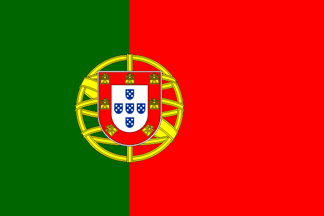
2:3, image by Vítor Luís and António Martins-Tuválkin, 23 Sep 2004
See also:
Introductory note
While the President’s flag is still used nowadays,
I’ve never seen any of the other ministers, and I wouldn’t be
surprised if they were abolished after the 1974 revolution.
António Martins, 3 February 1998
Presidential Flag
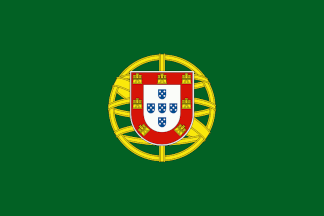
image by image by Vítor Luís and António Martins-Tuválkin, 14 Jan 2006
The President’s flag is a plain green 2:3 with the national
coat of arms (only sphere and shield, no
ribbon nor wreath) in the center.
António Martins-Tuválkin, 3 Feb 1998
I think it flies usually over the Palace of Belém, and I seem to recall
that I saw it flying over the Fort of São Julião da Barra (another real
estate that belongs to the portuguese presidency) when Jorge Sampaio lived
there for a while recovering from his heart operation. Further, every time
the president has some ceremony more pompous to attend, this flag can be
seen in his car.
Jorge Candeias, 22 July 1998
Just a few hours ago I watched a TV trivia quiz (O Jogo da Espera,
RTP1) where the very first question was «What is the meaning of a green
ensign »(= pavilhão, sic!)« hoisted in Belém
Palace?» Being this the official portuguese PR residence and even
though the question is misworded (the PR flag is green with the coat
of arms), this may mean that the presidential flag is a presence mark at
least at the official residence — and I’d bet it’s
the same in most military facilities, notably naval ships.
(If I were at the quizz I’d loose my 30000 euros to jest that a
plain green flag (and not the proper PR flag with arms) hoisted at the
presidential palace can only mean that either we were invaded by
Libya or that it is safe
to swim at the palace…)
António Martins-Tuválkin, 22 May 2002
Erroneous Depictions of the Presidential Flag
It is interesting to note that the two most widespead
representations of this flag are both incorrect, while the flag itself,
being a presence mark, is not often seen:
Presidential square flag
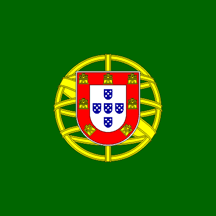
image by António Martins-Tuválkin, 14 Jan 2006
In an itinerant exhibition about the history of the Portuguese national flag and on its catalogue , the presidential
flag is shown square.
Source: "Bandeiras de Portugal"
Presidential flag with off-centred arms
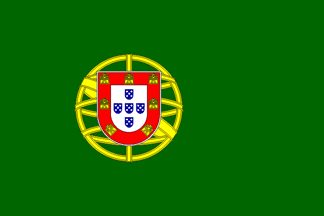
image by António Martins-Tuválkin,
In a full page feature about the national flag, it is shown with the arms off- centred
to the hoist, in the same position as in the national flag, instead of centred.
Source:Diário de Notícias_ (one of the best regarded and widely read daily newspapers in Portugal), editon 13 Jan 2006
António Martins-Tuválkin, 14 Jan 2006
Primeminister Flag
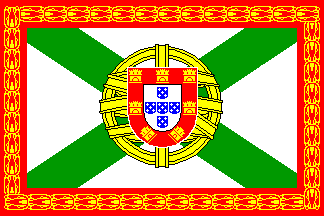
image by Zoltan Horvath, 4 Sep 2024
The Prime Minister flag is like a regular
minister’s flag,
but differs by a gold on red laurel border.
António Martins-Tuválkin, 3 Feb 1998
A flag for the Prime Minister was adopted 2 february 1972. This flag
is like the flag of the President, but is white with a green saltire with
the Arms (sphere and shield) at the centre. There is a red border on all
four sides with a pattern of laurel leaves in gold. This replaces the
former flag of the Minister of defence.
Mark Sensen, 5 June 1997,
quoting
[barXX]
Minister Flag
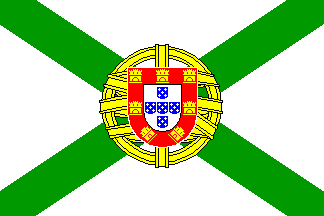
image by Mark Sensen and António Martins
The Minister flag is a 2:3 white with green saltire charged with the
coat of arms in the center.
António Martins-Tuválkin, 3 Feb 1998
An ordinary Minister has the same flag
[as the prime-minister] but without border.
Mark Sensen, 5 June 1997,
quoting
[barXX]
Flag of the Minister of the Navy
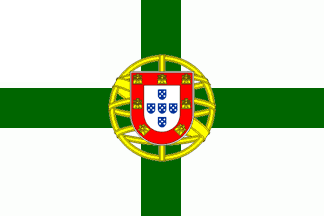
image by Mark Sensen and António Martins-Tuválkin, 22 July 1998
There is no “Ministery of the Navy” anymore, so its flag
if still exists, must be used by the ministery of defense, or by the
president in his condition of supreme commander of the armed forces.
Jorge Candeias, 22 July 1998
The Navy Ministry uses a regular cross throughout instead of saltire,
being this the “top” level for green-cross-on-white
naval rank flags of the Portuguese Navy.
António Martins-Tuválkin, 3 February 1998
The Minister for the Navy has a white flag with a green cross of
Saint George, with the Arms in the centre.
Mark Sensen, 5 June 1997
quoting
[barXX]
Flag of the Minister for War
The Minister for War has a flag divided vertically like that of the Army,
but with five white stars over all, arranged in a ring.
Mark Sensen, 5 June 1997
quoting
[barXX]
Parliament flag
![parliament flag [PT]](../images/p/pt_ar.gif)
image by António Martins-Tuválkin, 31 Dec 2006
On 28 December 2006 vexillologist Ricardo Monteiro reported the existence
of a parliament flag, approved on 14 December 2006 and published as
Resolução da Assembleia da Repúública n.º 73/2006 in
Diário da República: I Série on 28 December 2006
See also here
It is a new law, creating, describing, authorizing and regulating the flag
of the Portuguese "National Assembly" (parliament). It follows the pattern
of the presidential flag, with the sphere Coat of arms centred on a white flag
with a wide dark green border (width 1/6th of the flag's height).
António Martins-Tuválkin, 31 Dec 2006
Serviço de Estrangeiros e
Fronteiras
SEF - Service of Borders and Foreign
Nationals
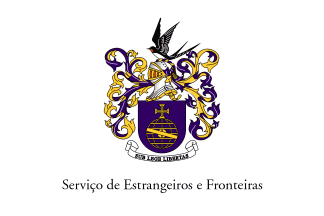
image by Jorge Candeias, 7 Sep 2003
According to an recent Público newspaper photo,
the flag of SEF is a light monocoloured (almost certainly white)
flag with the service’s coat of arms
and the service’s name, centered.
Jorge Candeias, 7 Sep 2003
Arms detail
sef.gif)
image by Jorge Candeias, 8 Sep 2003
The arms is very heraldic, with a helm topped by a swallow as
crest, a scroll with the service’s motto («SUB
LEGE LIBERTAS» — i.e. latin for
«Freedom under the law») and a dark purple
shield containing an armillary sphere
topped by a cross of the Order of Christ,
all gold. This coat of arms can be seen in several sizes at the
service’s website.
(While the versions at the website show all the elements of the
arms filled with 3D shadings, the arms as depicted in the flag does
not, at least in the portion of it that is visible in my photo
source.)
Jorge Candeias, 7 Sep 2003
The swallow was chosen (I reckon) because it is a migratory bird,
and this government institution (dependent from the Ministry of Internal
Affairs) deals mostely with immigration issues.
António Martins-Tuválkin, 9 Sep 2003
Health Ministry flag
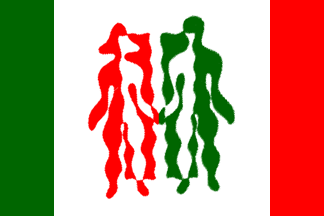
image by António Martins, 6 September 2003
I saw this one hoisted at the local ambulatory in Colares, Sintra.
It is the usual logo of the portuguese Health Ministry on a white square
background, “completed” up to 2:3 with two stripes: green at
the hoist and red at the fly. I could not confirm its officialness.
António Martins, 6 Sep 2003
back to Portugal main page click here
 klaus-michael schneider
klaus-michael schneider








![parliament flag [PT]](../images/p/pt_ar.gif)

sef.gif)
